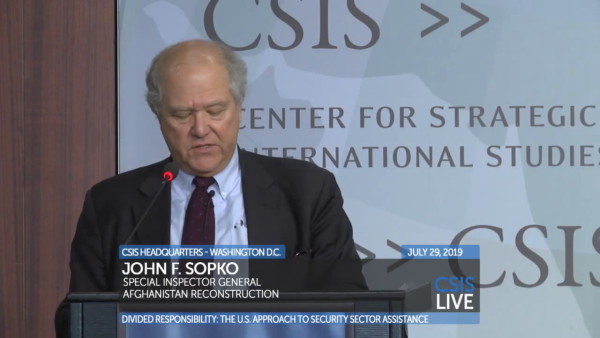

The deployment of the first of the Army’s specially-trained Security Force Assistance Brigades to Afghanistan in 2018 was supposed to be something of a moment of truth for a Pentagon stretched thin by the ever-expanding Global War on Terror.
But according to the U.S. government’s chief watchdog for the U.S. military campaign, the units that were supposed to act as the tip of the spear for the Army’s newfound emphasis on “advise-and-assist” missions have a major problem: they simply can’t find enough soldiers to get the job done.
Speaking at the Center for Strategic and International Studies about the Special Inspector General for Afghanistan Reconstruction’s June 2019 report on security assistance efforts, SIGAR chief John F. Sopko stated that the 1st Security Force Assistance Brigade (SFAB) that deployed in the spring of 2018 simply couldn’t find enough experienced advisers to actually get the job done.
“Staffing of the SFABs is based on recruiting active-duty Army and National Guard volunteers, but while advisory experience is preferred, about 20 precent of the 1st SFAB had never previously deployed,” Sopko said. “And even though the Army offered a number of incentives for volunteers, the 1st SFAB was filling billets right up to the day that they departed.”
Capt. Justin M. Alexander, a combat advisor team leader for 1st Battalion, 1st Security Force Assistance Brigade, walks with an Afghan National Defense Security Forces role player during a simulated event at the Joint Readiness Training Center in Fort Polk, La., Jan. 13, 2018
(U.S. Army/ Pfc. Zoe Garbarino)

The 1st SFAB didn’t just suffer from recruitment challenges, but retention issues as well. The reason is simple, Sopko said on Tuesday: Adviser roles “continue to be seen as not career enhancing in the military, which contributes to high attrition rates — up to 70 percent for the 1st SFAB.”
This is a clear miss for the Army’s SFAB effort. As Task & Purpose previously reported, each SFAB is supposed to comprise a force of between 400 and 500 senior officers and NCOs plucked from the best in the Army’s infantry and armor branches and evaluated along similar criteria and regimental physical fitness requirements on part with U.S. special operations forces with the 75th Ranger Regiment.
“In training, we’re looking at an individual component: What makes a good advisor?” 1st SFAB Deputy Commander Col. Bryan Chivers told Task & Purpose at the time “There are academic and practical exercises, negotiations, language elements, a collective component that includes medical training and lethality for force protection. But then there’s subject-matter expertise depending on individual rank and specialty, and we’re trained to operated in field environments and academic environments.”
But beyond career considerations, Sopko pointed to another clear reason why experienced soldiers might appear disinclined to dive headfirst into an SFAB: it was an organizational clusterfuck: According to the June 2019 SIGAR report, “no military service was assigned responsibility of ownership for developing [Afghan National Defense and Security Forces] combat capabilities.” This resulted in truncated security assistance activities that in turn hampered efforts to develop and execute multi-year programs.
“These divisions often created strains on both unity of command and unity of effort, and I believe led to that oft-used quote that we didn’t fight one 18-year war in Afghanistan, but we fought 18 one-year wars,” Sopko said. “And I would say we fought 36 wars because many of the people sent to Afghanistan served only 6 months.”
Any experienced warfighter knows that actually caring about your mission matters, but there’s only so much dysfunction and organizational turbulence a person can take before they call it quits. Sure, SFABs may have been given their own staff, support, and intelligence elements, not to mention the most advanced new gear available; according to Sopko, they simply weren’t enough to attract the best and brightest from within the Army.
